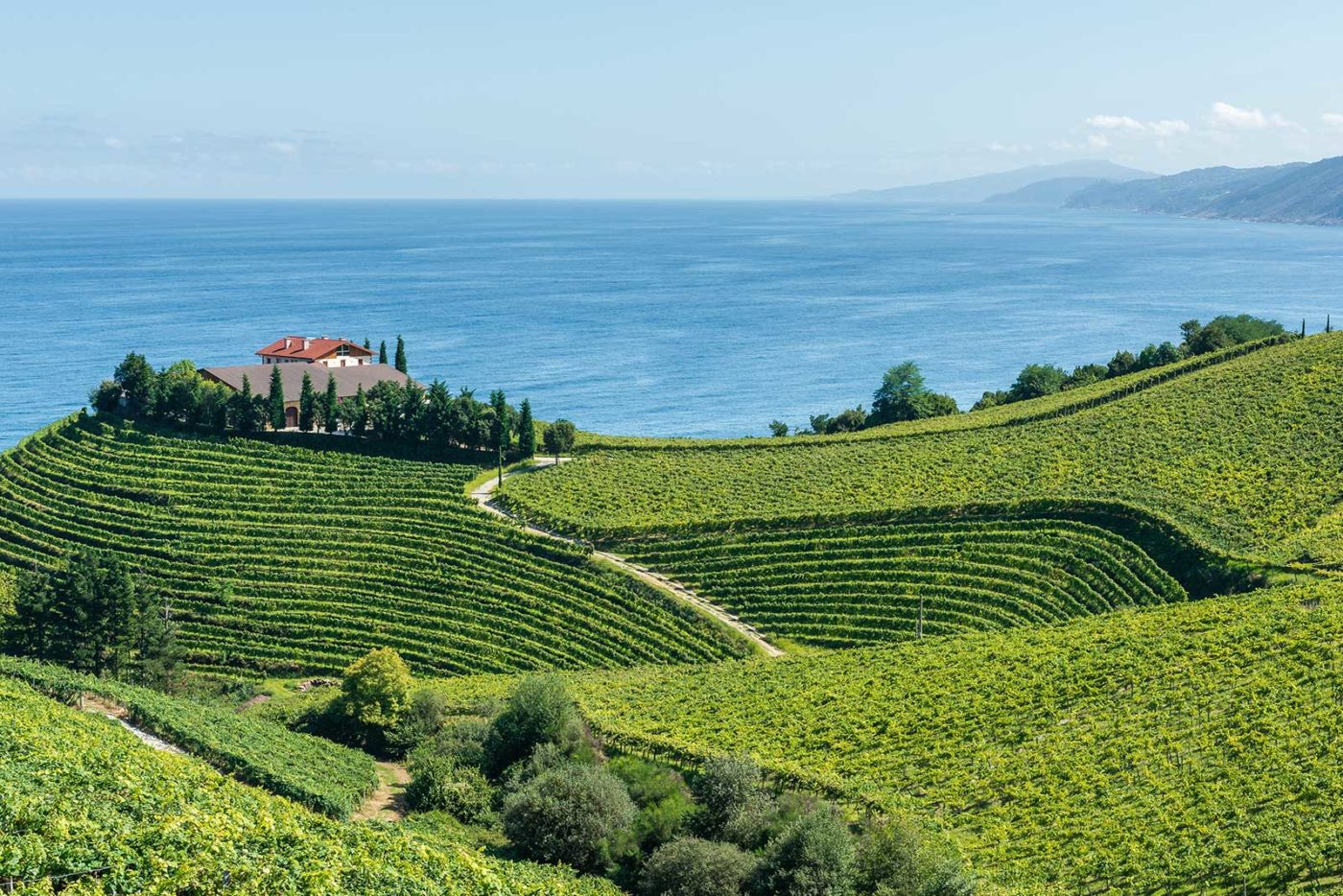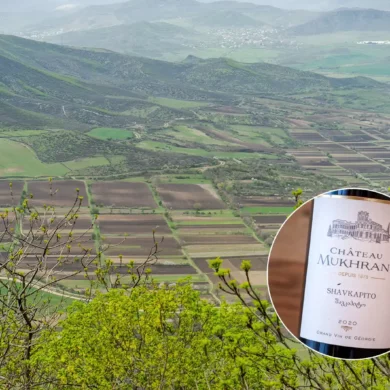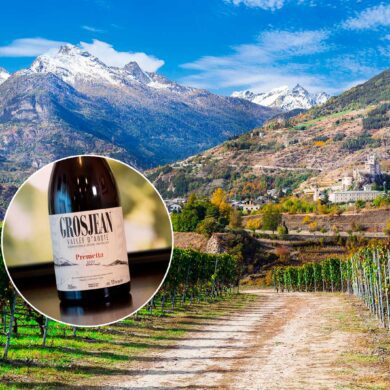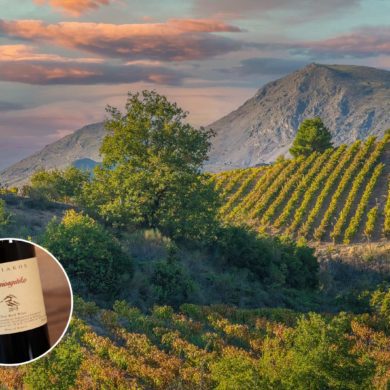Txakoli — the mineral-driven, low-alcohol, slightly-spritzy whites produced in far northern Spain along its North Atlantic coastline — may very well be the most (and yet, least) Spanish of the country’s wines. Traditionally served via an ostentatious and decidedly unpretentious overhead pour, Txakoli (pronounced cha-ko-lee) wines exhibit a certain contempt for stuffiness even before they’ve made it into the glass. Once there, their bright, youthful character and zippy acidity seem purpose-built for social drinking over shared plates on a warm afternoon — an activity at which the Spanish excel.
But Txakoli (sometimes known as “Txakolin” or “Txakolina”) also represents a departure from what most of us think of when we hear “Spanish wine.” It hails from a small corner of the Basque Country, a region that doesn’t even lie entirely within Spain and — depending on who you ask — isn’t even necessarily Spanish. In a country best known for wines produced on sun-baked inland hillsides and arid high plateaus, Txakoli comes from the stony seaside hills overlooking the Cantabrian Sea, where year-round rains and winds off the North Atlantic keep things relatively cool and wet. It’s made from grapes you’ve likely never heard of (most prominently Hondarrabi Zuri) by producers with names you likely can’t pronounce (Txomin Etxaniz, Bengoetxe, Ameztoi).
Yet the wine itself is fairly straightforward: Light-bodied, low-octane, bone-dry and ever-so-slightly fizzy, with predominant aromas of green apple, lemon, grapefruit, and sometimes fresh green herbs. On the palate all that green fruit and citrus wraps tightly around a solid mineral core, enlivened by a measured dose of natural carbonation imparted during fermentation that provides Txakoli its signature subtle spritz. All this is often complemented by a hint of salinity reminiscent of its origins overlooking the North Atlantic.
Those cool, rainy, coastal origins don’t make for easy winemaking, which is why Txakoli (“homemade wine” or “farm wine” in the local language) was sliding toward extinction as recently as the late 1980s. A resurgence in interest — first within Spain, then across Europe and the U.S. — is widely attributed to a global recognition of, and fascination with, Basque cuisine beginning in the 1990s. Tourists flocking to the region — alongside food media and television camera crews — were introduced not only to Txakoli but to its traditional pour. This theatrical service ritual involves pouring long streams of pale Txakoli wine into flat bottomed glasses from bottles held high overhead, invigorating the small amount of natural carbonation in the wine as it strikes the bottom of the glass with a satisfying SMACK heard round the dining room.
In serious restaurants run by serious Basque-proud chefs, diners began to realize that Txakoli isn’t just an excellent foil for the region’s ample seafood, nor is it simply a pleasing low-alcohol aperitif (though it’s definitely both of those things). Txakoli is joie de vivre. Tkakoli is fun. The resulting spike in popularity means consumers across Europe and the U.S. can now find Txakoli relatively easily, and typically for less than $20. Both the cost and the character of these wines dictate that you don’t need an occasion.
Looking for a good starting place with Txakoli? Ameztoi’s “Getariako Txakolina” is a regular fixture in my fridge and comes out whenever the occasion calls for something crisp, refreshing, and not too spendy. It is also widely available. Made from 100% Hondarrabi Zuri grapes and fermented in sealed, stainless steel tanks, it’s bright, mineral-driven, and dry as can be — the perfect accompaniment to raw seafood or fish tacos or simply a picnic blanket stretched across a shady patch of grass on a summer afternoon.
Serve it cold on a warm day. Maybe attempt the traditional pour. Whatever you do, consume with joy.
Ameztoi Getariako Txakolina 2020
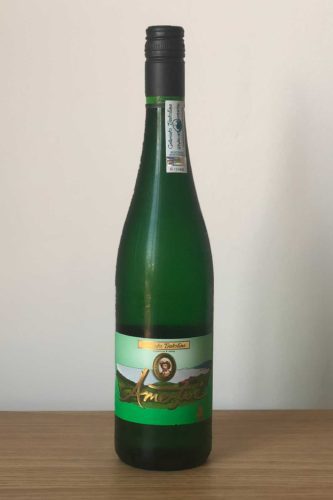 Getariako Txakolina DO (Gipuzkoa, Basque)
Getariako Txakolina DO (Gipuzkoa, Basque)
Grapes: Hondarrabi Zuri (100%)
Alcohol: 10.5%
Opinion: ★★★★ 1/2 (out of five)
• Food Friendliness: Versatile
• Value: Very good
A beginner might like … The fresh uncomplicated-ness of this bright, dry, gulpable wine. There aren’t layers upon layers to unpack here, just a wine best consumed purely for pleasure, ideally outdoors on a warm day. There’s no room for overthinking.
A wine obsessive might like … Txakoli’s bracing acidity, minerality, and under-the-radar street cred. For example, you’re not exactly spoiled for choice if raw seafood is on the menu, but bring out this wine when your go-to Muscadets, Albariños, or Vinho Verdes are feeling a bit tired. Maybe even wow your dinner guests with an ostentatious Basque pour.

